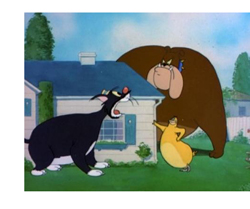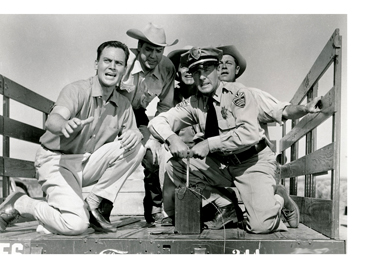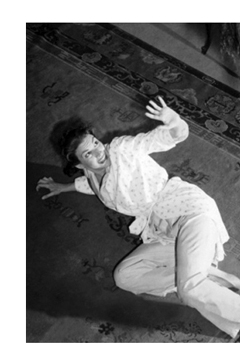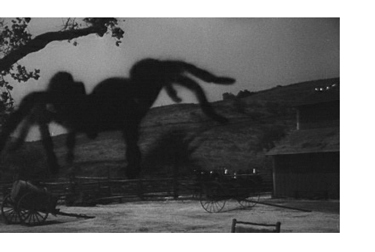Reviewed by Glenn Erickson
These days fantasy film fans are finding it necessary to invest in all-region Blu-ray players. Our studios don't see a market in older genre pictures, but happily license them to boutique companies, even foreign ones. Cue this story of "Eine Stadt in Angst und Schrecken!," suitable for monster fans from the Rhine to Germantown, Pennsylvania. In its timely way DVD Savant is right on top of this release, which came out almost a year ago.

Universal-International took a flyer in the Big Bug business when producer William Alland purloined the premise of Warners' giant hit Them! and placed it in a budget version of the desert town from It Came from Outer Space. Thus was launched a hundred film-school treatises extolling the 'Arnoldian Desert Motif.' Yet Tarantula works up its own broth of monster thrills and strange poetic effects. While the human characters exchange small talk a colossal black arachnid stalks the wide-open desert spaces. As big as a mountain, it nevertheless escapes detection and snacks on various peripheral characters in approved monster-on-the-loose fashion.
The denizens of sleepy Sand Rock, Arizona are unaware of the caliber of disaster INdicated by the presence of a biology lab in their community. Professor Gerald Deemer (Leo G. Carroll) and his two associates have been toying with a radioactive growth-inducing serum because overpopulation will bring about epidemics of starvation in just twenty years (1955 + 20 = 1975). Through a regrettable sequence of events, all three researchers receive injections of their own super-vitamin, resulting in their disfigurement and death from symptoms that look like the disease acromegaly. Deemer's new assistant Stephanie 'Steve' Clayton (Mara Corday) arrives to find Deemer's lab in disarray. She and the town doctor Matt Hastings (John Agar) discover that a test spider has escaped from the lab and grown to gargantuan proportions. It's roaming the countryside devouring horses, truckloads of beef and the truck drivers as well.

Tarantula subscribes to the can't-miss formula for '50s monster entertainment: make sure your monster is bigger than last year's. Led by optical whiz David S. Horsley, the Universal optical department puts a lot of effort into twenty or so angles showing the giant spider striding down highways, knocking over power lines and sneaking up on unlucky motorists. As with the previous year's giant ants, the outsized crawling bug is accompanied by a loud signature noise that sounds like sizzling bacon. Unlike Warner's ants, the only practical full-scale part of the spider we see is one hairy palp-fang that smashes through a roof.
Gigantism in movies is not easy to pull off. The design geniuses behind Metropolis and King Kong knew how to cheat the scale of our perceptions to make things LOOK REALLY BIG, a skill that evaded the makers of Beginning of the End and The Giant Gila Monster. Here the Universal optical department succeeds most of the time. The monster shots were done by shooting various spiders high-speed (to get the slow motion) and in deep-focus. The miniature landscapes was shaped to conform to the contours of the real desert in the live-action footage. When carefully matted into the picture the spider seems to 'fit' the hills and rocks, and even throws a shadow. The sight of the spider stepping over an outcropping two or three miles away is undeniably impressive. He makes a wonderfully subtle entrance creeping up behind a pair of friendly prospectors, with one telltale leg silently peeking over the horizon.
Perspective issues remain, as the hairy arachnid has a tendency to appear a mile across in the far background, only to shrink to a hundred feet or so when he reaches the foreground. Since the performing spiders could only be guided with jets of air, Clifford Stein's camera team must have burned up a lot of film to get useable footage, and been grateful whenever an angle matched up at all. Then again, the amount of light poured on to obtain the necessary depth of focus, probably made the miniature sets so hot that the spiders needed little encouragement to walk.
After all that effort, it looks as though the cameramen weren't allowed to finesse the mattes, as several shots show the spider's legs disappearing into mattes that cut across the sky. In a few others, parts of the spider are transparent.

But the effect can be stunning. One pre-dawn moment places Universal's ubiquitous Southern mansion on the right side of the screen, with a real desert landscape dominating the left. Off in the distance we can see the tarantula advancing this-a-way, an Arizona Highways Calendar gone surreal. It might be crawling into our reality from another dimension. He's a horrifying menace, but still so far away that it's much too soon to panic. I have nightmares like this.
In its best entrance, the spider suddenly reveals itself to the cast as they stand by their cars on stretch of desert road. It charges up over the crest of a hill and then freezes, as if holding still to evaluate its new dining opportunity. Then it resumes its machine-like crawl, accompanied by Henry Mancini's menace music recycled from This Island Earth. 1
Lovely Mara Corday has the task of looking concerned while pretending to be an eager research assistant in designer clothes. It's neither her nor John Agar's fault that the script keeps Matt and Steve way behind the story curve, always looking for answers that the audience already has. Dr. Hastings' scripted reveries about the desert are filler material meant to echo Richard Carlson's speeches from It Came from Outer Space, but Agar hasn't the chops to deliver them. Researcher Leo G. Carroll suffers the yokels' anti-science bias, as when the sheriff slights him with the remark that all scientists are rude. Deemer is presented as sympathetic, but he also buries a colleague out in the desert, almost like Norman Bates from Psycho.. Carroll handles a squirming monkey like a pro. But we never understand exactly why his associates would consider taking a drug that transforms
 bunnies and hamsters into 'sizeable beasts.' Haven't they seen the Tex Avery cartoon King Size Canary? 2
bunnies and hamsters into 'sizeable beasts.' Haven't they seen the Tex Avery cartoon King Size Canary? 2
Tarantula collapses into hilarity at least once, when the giant spider (partially in its poorly-matched puppet version, the one seen on the poster) imitates King Kong by peeking into Mara Corday's dressing room through a convenient giant-sized window. Mara strolls to and fro (and even looks in a mirror) but never notices a fifteen-foot glittering monster eyeball ogling her only a few feet away. When the spider subsequently climbs on top of the house and proceeds to batter it to pieces, it really appears to be, uh, aroused. The filmmakers had to be aware of this association; it must have been screamingly funny in 1955 drive-ins.
Other items like the useless data recording sheets by which Deemer keeps track of his experimental subjects, are funny in a sort of depressing way -- they really are aimed at 6-year olds. So are the Matinee- worthy wince-inducing scientific explanations. In a category by itself are the large pools of chalky white tarantula venom left behind at all the attack sites... could they be a clue? While the wiseacres in the audience make off-color remarks, John Agar's intrepid country sawbones dips his finger into a puddle and gives it the taste test. What if it's the acid stuff that the University expert says the spider uses to liquefy its prey? Matt Hastings could end up looking worse that drippy-faced Dr. Deemer.
Clint Eastwood (or at least his voice and eyes) is the pilot guiding the Napalm strike that turns the spider into a big fireball. Unlike other giant '50s threats, this monster is such an easy target that the movie could serve as an institutional ad for Du Pont or Dow Chemical. One phone call to your local Air Base does the trick: the bigger they come, the brighter they burn. Tarantula has always been a guilty favorite of giant monster fans, and fits in there right behind the top ten or so sci-fi offerings of the 1950s.

Koch Media's Region B Blu-ray of Tarantula has two encodings of this impressive giant bug picture, a full frame version for viewers wishing to re-create what they've seen on TV for the last sixty years, and a 1.85:1 scan that reflects how it was originally shown in theatrical presentations. This viewer's bias is in favor of the widescreen version. Jack Arnold's TV blocking looks flat enough widescreen, but when the upper and lower extremes of the frame are opened up the action is frequently remote and unfocused. The compositions with the giant spider are also greatly improved.
For Luddites claiming that the flat transfer is 'correct,' I point to the medium shot just before the main title, where the deformed, dying scientist falls down on one elbow. The widescreen shot frames him tightly, but the full frame scan reveals the big fat honking shadow of a lighting flag at the bottom of the screen. So there. 3

The image quality is very good. With the added detail we can see that the optical experts' mattes hardly ever matched well. The spider repeatedly appears from behind a false horizon floating above the real one. Yet when the perspectives match the effect is still impressive. The transfer artistes have adjusted the density to minimize print-through, but can't disguise shots where lighter areas of the spider, mostly the joints, also become transparent. On the other hand, a couple of shots of rockets impacting next to the spider have very sophisticated mattes working, to link the larger-scale explosions both to the miniature spider and the larger desert backplate image. The illusion is very good.
The exceptionally clear audio appears to slightly subdue the 'frying bacon' spider sound effect in the last scene. That 'presence' effect alternates with a jet noise effect when the action cuts between the spider on the ground and Eastwood's F-94s up above. An audio cutting error is still there, when the 'sizzle' effect changes to the 'whine' effect about a second too late across one cut. I just thought I'd demonstrate how many times I've seen this thing.

Koch Media must have some eager monster fans on its staff. The extras include both an American trailer and a textless copy with video-added German text superimposed. We also get copies of both the regular-8 and Super-8 home movie digest versions. Uh, mine is still somewhere in the garage. The German title sequence is another menu item, along with a lengthy (150-page) image gallery that seemingly carries every still photo and bit of ad art ever made.
The want-to-see Jack Arnold interview is 24-minutes long. It was filmed at a production office not long before he passed away, for he refers to the sale of Columbia to Sony, which began in 1989. We see what looks like a maquette for a re-designed Gill Man on Arnold's desk. In the default track a spoken German translation blocks out Arnold's voice, but choosing track 2 reverts to the unobstructed English. When Arnold talks about his old movies he mentions nobody else, speaking as if he came up with the ideas and wrote all the scripts on his own. Tarantula did of course originate with a Science Fiction Theater episode he directed called "No Food For Thought." But that show was also written by Tarantula's Robert M. Fresco. That's not to say that U-I's distribution of screen credit at this time was accurate. Department head Bud Westmore gets sole credit for makeup, for instance, so the craftsmen and artists that created the film's monsters largely remain unnamed. The music composers are also uncredited. Universal executive Joseph Gershenson receives the only onscreen credit, as a Music Supervisor.

Arnold assures the interviewer that Tarantula in no way copied Them! Every kid in America knew better. Arnold's movie even has a scene where scientists look at docu footage of tarantula spiders, just as Edmund Gwenn had trotted out a projector to show his movies of ants. In both movies the show & tell scenes explain exactly what kind creepy crawlies mankind is up against. Personalities like Arnold had no way of knowing that intense fan scrutiny and the Internet would eventually fact-check every statement he made on camera.
Another German disc company released widescreen Blu-rays last year of The Mole People and The Monolith Monsters. In a few days Koch Media will release a German Region B Blu of The Incredible Shrinking Man, a Sci-fi classic so good that Jack Arnold can boast about it all he wishes. 4
On a scale of Excellent, Good, Fair, and Poor,
Tarantula Region B Blu-ray rates:
Movie: Very Good
Video: Excellent
Sound: Excellent
Supplements: Jack Arnold interview (German only), German title sequence, home video digest versions, two trailers, extensive image gallery.
Deaf and Hearing-impaired Friendly?
YES; Subtitles: English
Packaging: One Blu-ray in Keep case
Reviewed: May 10, 2015

Footnotes:
1. The tarantula's 'charge in and freeze' entrance seems to have inspired the third Lord of the Rings movie, in the scene in which the spider monster Shelob suddenly appears from a mountainside cave.
Cartoonist Gahan Wilson nailed Tarantula's surreal gigantism effect in a Playboy cartoon around 1967. Two guys at a tiny highway burger shack stare at the dark hills far away. One of the hills is really a toad-like monster with two gigantic eyes, and it looks like it's crawling in their direction. Realizing that the shack's neon sign reads "EAT", one customer says, "My God -- do you suppose it can READ?"
Return

2. Speaking of Tex Avery's King Size Canary, Leo G. Carroll's elaborate, Quasimodo-eyed makeup makes Dr. Deemer into a dead ringer for Avery's Droopy Dog character. Carroll even talks a bit like Droopy.
Return
3. A salient example of another unwanted full screen 'revelation' is in The Creature from the Black Lagoon. Experts including Tom Weaver reported for years a goof in a shot of the boat in the jungle lagoon, where a telephone pole can be seen at the top of the frame. Well, that only happens in incorrect un-matted TV prints. In the correct 1:78 scan, it's cropped away.
Return
4. In vintage interviews director Jack Arnold and producer William Alland often bad-mouthed their sci-fi movies. When talking to eager genre scribes, they showed more enthusiasm while claiming personal credit for every successful aspect. I would like to have seen the two men in a double interview, with perhaps Tom Weaver prodding them on every sensitive point of contention. It would be right up there with a fantasy interview feud between the writer-director Ib Melchior and producer-director Sid Pink. Melchior sometimes overstated the realism of his stories, but Pink had a habit of taking credit for all of Melchior's achievements.
Return
5. Makeup authority Craig Reardon writes in regarding Tarantula, 5.10.15:
I find it permanently amusing that the first deformed scientist we see is a denuded 'Mr. Hyde' mask left over from Abbot & Costello Meet Dr. Jekyll and Mr, Hyde. And then... the NEXT deformed scientist is a "Mr. Hyde" mask as well. Except that this time they throw in -- or on -- one of those big-lobed foreheads made for This Island Earth, glued onto the "Hyde" forehead at a jaunty angle. It took me years to realize just what I was looking at, there. The meaty hands of the mutated scientists seem to me to be the only thing they made custom for this movie, besides the melting candle-head makeup for Carroll, which makes absolutely no sense whatsoever. The two earlier colleagues died with a coarsening of their features which is at least conceptually correct for someone suffering from acromegaly. But, what the hell is happening to Leo G. Carroll? That is NOT acromegaly, folks! That is, "Quick, blow out the candle!"
Along with all the other fans of this series I'm looking forward a to The Incredible Shrinking Man and hoping somebody puts out a nice HD version of This Island Earth as well. Thanks -- Craig

Text © Copyright 2015 Glenn Erickson
See more exclusive reviews on the Savant Main Page.
The version of this review on the Savant main site has additional images, footnotes and credits information, and may be updated and annotated with reader input and graphics.
Return to Top of Page
|



